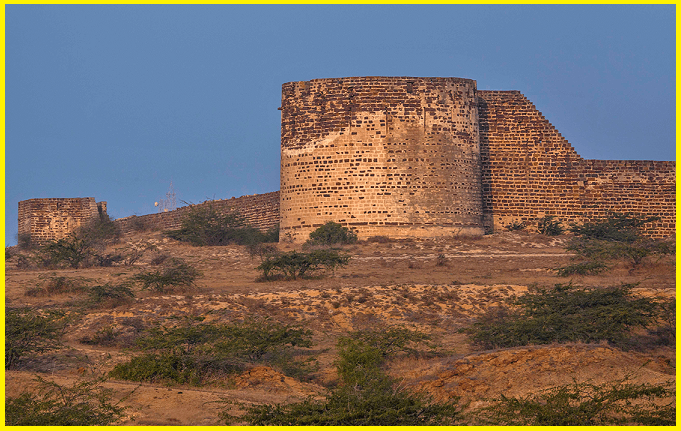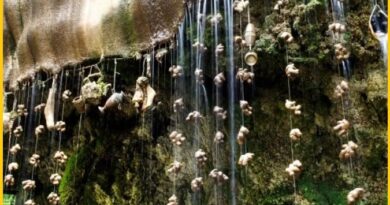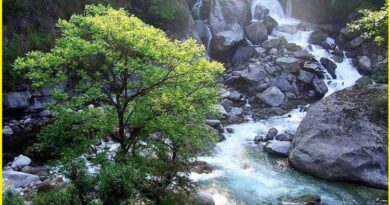Lakhpat Fort Kutch- The Glorious fort admire by Guru Nanak dev
Lakhpat fort Kutch
Lakhpat Fort is a historic fortress located in the Kutch district of Gujarat, India. It was built in the 18th century by Rao Lakha, who was a local chieftain and one of the prominent rulers of Kutch. The fort is Only 33 km north of Narayan Sarovar, with a walled fort as its main highlight. The Fort is situated at the mouth of the Kori creek, which offers testimony to a short but glorious past. One can climb the fort rampart, the only remaining structure of the fort, and look over at the placid sea. This spot is particularly stunning at sunset. Within the fort walls, also lies a 16th-century gurdwara. It is believed that Guru Nanak stopped here twice during his second (1506–1513) and fourth (1519–1521) missionary journey called Udasis. The gurdwara is a soothing spot for travelers.
The Fort premises consist of several structures such as temples, palaces, and residential buildings. The most notable among them is the Lakhpat Palace, which was the residence of the rulers of Kutch. The palace is built using white marble and has intricate carvings and designs. Lakhpat fort Kutch also has several temples such as the Ganesh Temple, Shiva Temple, and Jain Temple. The temples are known for their architecture and intricate carvings.

Geology
The Lakhpat region is characterized by a variety of geological formations, including sedimentary rocks, volcanic rocks, and alluvial deposits. The sedimentary rocks in the area include sandstone, limestone, and shale, which were formed millions of years ago through the deposition of sediment in ancient seas and rivers.
The region is also known for its volcanic rocks, which are part of the Deccan Traps. The Deccan Traps are a large volcanic formation that covers a significant portion of western and central India and was formed around 65 million years ago due to a massive volcanic eruption. The Lakhpat region also has extensive alluvial deposits, which were formed due to the deposition of sediment by the Sindhu River. The alluvial deposits in the area are rich in minerals and are used for agriculture.
Also, read- Kalo Dungar Gujarat- A Stunning sea facing hill known for Unusual Phenomenon
Lakhpat fort history
Lakhpat Fort has a rich history dating back to the 18th century. It was built by Rao Lakha, a local chieftain and one of the prominent rulers of Kutch. Lakhpat fort in Kutch was constructed with the aim of protecting the Kutch region from invasions by neighboring kingdoms and promoting trade and commerce. It served as a major gateway for trade between India and Central Asia. The fort was strategically located on the banks of the Sindhu River, which was an important trade route during ancient times.
Lakhpat fort in Kutch is situated near the India-Pakistan border and was constructed using locally available materials such as stone and mud. It is spread over an area of 7 kilometers and has several gates, bastions, and watchtowers. The fort walls are more than a meter thick and were built to withstand attacks from enemies.
During the 19th century, the fort was under the control of the British East India Company. It was later abandoned in the 20th century, and the surrounding town of Lakhpat gradually declined. Today, the fort is a popular tourist attraction and is known for its historical significance and architectural beauty. In recent years, efforts have been made to restore the fort and the surrounding town of Lakhpat. The government of Gujarat has initiated several development projects to promote tourism and economic growth in the region.
Gurudwara Lakhpat fort
Gurudwara Lakhpat Sahib is a historic Sikh shrine located inside the Lakhpat Fort complex. It is believed to have been built in the 18th century in memory of Guru Nanak Dev visit to the area, the founder of the Sikh religion. According to Sikh tradition, Guru Nanak stopped here twice during his second (1506–1513) and fourth (1519–1521) missionary journey called Udasis. The soft hymns play constantly in the background, as travelers visit the ancient Sikh place of worship. During his stay, he preached the teachings of Sikhism and performed several miracles, which earned him the respect and admiration of the local people.
The Gurudwara is situated inside the fort complex and is one of the main attractions for Sikh pilgrims and tourists visiting the region. The shrine is built in the traditional Sikh style of architecture, with a dome-shaped structure and white marble walls. The Gurudwara also houses several historical artifacts related to Guru Nanak Dev, including his shoes, a manuscript of the Guru Granth Sahib, and a sword believed to have been used by him. The shrine also has a sacred pond where pilgrims can take a dip and offer prayers.

Kori Creek Kutch
Kori Creek is a tidal creek located in the Kutch district. It is situated 15 km south of the city of Mundra. A creek is a small, narrow stream of water that flows through a channel or bed in a natural landscape. Creeks are typically fed by rainfall or runoff from nearby hills, and they may empty into larger bodies of water such as rivers, lakes, or oceans.
Kori Creek is an important ecological zone and supports a variety of marine and bird life. It is also a major centre for shrimp farming and fishing activities, with many small fishing villages located nearby. In recent years, Kori Creek has also become a site for industrial development, with several large industrial projects being planned or under construction in the surrounding area. However, this development has raised concerns about the potential environmental impact on the fragile ecosystem of the creek.
Narayan Sarovar
Narayan Sarovar, one of the holiest lakes of Hindus, is sacred to Lord Narayan. It is located in Lakhpat taluka of the Kutch district. The ancient Koteshwar temple lies only 4 km away. The lake is mentioned in Hindu Purans as five lakes (Panch-Sarovar) -Mansarovar, Bindu Sarovar, Narayan Sarovar, Pampa Sarovar, and Pushkar Sarovar.

Bhuj to Lakhpat fort
Bhuj is the nearest major city to Lakhpat Fort, located at a distance of approximately 135 kilometers. The city is also the nearest airport to Lakhpat Fort. There are regular flights from major cities across India to Bhuj. From the airport, one can hire a taxi or take a bus to reach Lakhpat Fort. The nearest railway station to Lakhpat Fort is the Bhuj Railway Station. The place is well connected by Road. There are regular state transport buses and private taxis available from Bhuj to Lakhpat.



